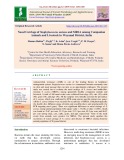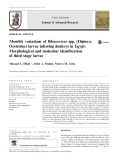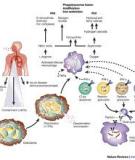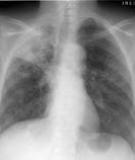
Nasal passages
-
Part 1 book "Equine endoscopy and arthroscopy for the equine practitioner" includes content: Endoscopy equipment, use and maintenance, endoscopy of the nasal passages, endoscopy of the paranasal sinuses, endoscopy of the guttural pouch, endoscopy of the nasopharynx, endoscopy of the larynx, endoscopy of the trachea and bronchi.
 116p
116p  oursky08
oursky08
 01-11-2023
01-11-2023
 6
6
 2
2
 Download
Download
-
Antimicrobial resistance (AMR) is one of the leading threats in healthcare management system. Staphylococcus aureus is a commensal bacteria commonly seen on skin and nasal passage that can turn as an opportunistic pathogen. The present study was carried out to evaluate the nasal carriage of S. aureus and methicillinresistant S. aureus (MRSA) among apparently healthy companion animals and livestock. A total of 160 nasal swabs were collected from dogs (30), cats (30), cattle (40), goats (30), and pigs (30).
 7p
7p  nguaconbaynhay4
nguaconbaynhay4
 22-03-2020
22-03-2020
 14
14
 2
2
 Download
Download
-
Myiasis is a term used to describe the invasion of tissues or organs of vertebrates with the larvae of dipterous flies. It is largely a problem in livestock, human infestations in rural tropical areas of the globe is uncommon. Myiasis may involve the skin, eyes, nasal passages, gastrointestinal and genitourinary tracts. Urinary myiasis is caused mainly by larvae of Fannia scalaris, Musca, Sarcophaga, Lucilia, Wohlfahrtia, Calliphora.
 3p
3p  caygaocaolon2
caygaocaolon2
 14-03-2020
14-03-2020
 10
10
 1
1
 Download
Download
-
This study was carried out to investigate the prevalence and monthly intensity of Rhinoestrus (R) spp. among donkeys slaughtered at Giza Zoo abattoir, Egypt. A total of 144 donkeys were examined at postmortem through two visits per month from January 2010 to December 2010. All donkeys were infested with one or more larval stages during all months of the examination period (100%).
 7p
7p  trinhthamhodang1
trinhthamhodang1
 16-11-2019
16-11-2019
 14
14
 1
1
 Download
Download
-
Particulate matter is arguably the most danger- ous component of automobile exhaust. Particles are small enough to infiltrate nasal, sinus, and bron- chial passages where they can accumulate and cal- cify. Fine PM can penetrate the deepest portions of the lungs and the very smallest particles can be absorbed into the bloodstream. In the nose, throat, and lungs, particulates act as extreme irritants. Exposure to even low levels of PM can cause na- sal congestion, sinusitis, throat irritation, cough- ing, wheezing, shortness of breath, and chest dis- comfort.
 67p
67p  saimatkhauroi
saimatkhauroi
 01-02-2013
01-02-2013
 35
35
 5
5
 Download
Download
-
The infectiousness of a TB patient is directly related to the number of droplet nuclei carrying M. tuberculosis (tubercle bacilli) that are expelled into the air. Depending on the environment, these tiny particles can remain suspended in the air for several hours. M. tuberculosis is transmitted through the air, not by surface contact. Infection occurs when a person inhales droplet nuclei containing M. tuberculosis, and the droplet nuclei traverse the mouth or nasal passages, upper respiratory tract, and bronchi to reach the alveoli of the lungs.
 38p
38p  enter1cai
enter1cai
 12-01-2013
12-01-2013
 48
48
 5
5
 Download
Download
-
M. tuberculosis is carried in airborne particles, called droplet nuclei, of 1–5 microns in diameter. Infectious droplet nuclei are generated when persons who have pulmonary or laryngeal TB disease cough, sneeze, shout, or sing. Depending on the environment, these tiny particles can remain suspended in the air for several hours. M. tuberculosis is transmitted through the air, not by surface contact. Transmission occurs when a person inhales droplet nuclei containing M.
 0p
0p  taisaocothedung
taisaocothedung
 12-01-2013
12-01-2013
 50
50
 1
1
 Download
Download
-
Oropharyngeal motor dysphagia results from impairment of the voluntary effort required in bolus preparation or neuromuscular disorders affecting bolus preparation, initiation of the swallowing reflex, timely passage of food through the pharynx, and prevention of entry of food into the nasal and the laryngeal opening. Paralysis of the suprahyoid muscles leads to loss of opening of the UES and severe dysphagia. Because each side of the pharynx is innervated by ipsilateral nerves, a unilateral lesion of motor neurons leads to unilateral pharyngeal paralysis.
 5p
5p  ongxaemnumber1
ongxaemnumber1
 29-11-2010
29-11-2010
 61
61
 2
2
 Download
Download
CHỦ ĐỀ BẠN MUỐN TÌM





















